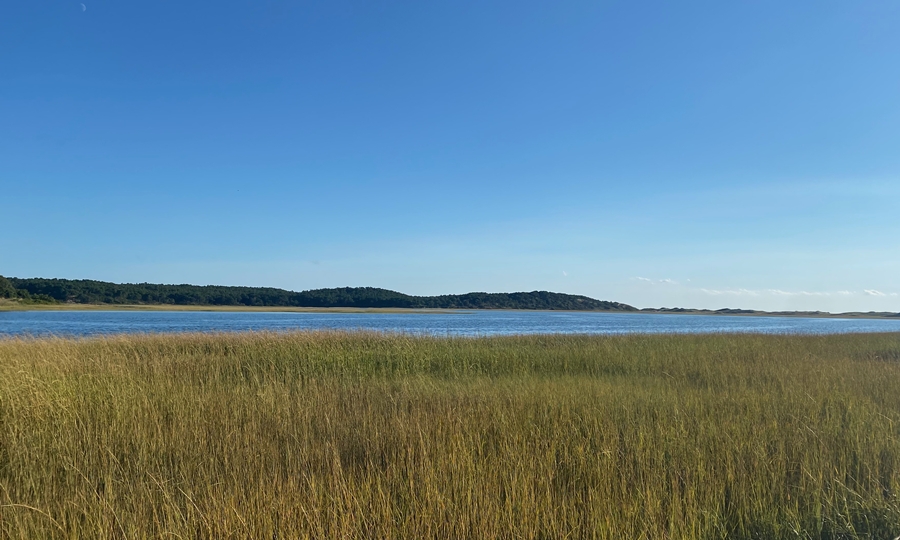WELLFLEET — After a recent round of amendments, a strategy for removing nitrogen from the town’s wastewater over next 20 years — part of the Targeted Watershed Management Plan — seemed to be on the home stretch to approval by the select board on April 29. Then it would finally be on its way to the Mass. Environmental Policy Office for review and public comment.
That meeting didn’t quite go as planned. Still, Wellfleet may now be looking at an improved approach to meeting nitrogen reduction goals by prioritizing septic system upgrades near wetlands and coastal waters.
The details of a hybrid approach involving a sewer system for the central district and new septic system rules for most other properties need to be sent to the state, with a cost estimate, by midsummer. That’s essential to applying for assistance from the Clean Water State Revolving Fund, which could cover some of the costs of implementing upgrades next year.
The town first submitted a draft of its watershed plan to the state in 2022. In 2023, the state found Wellfleet to be a nitrogen sensitive area requiring a 20-year plan to address water quality. The board of health took that on and brought its proposal for sewers and septic regulations to the select board in August 2024. After further discussion, the health board returned to the select board last December. Select board members were concerned about the plan’s reliance on “triggers” such as home sales and new construction and asked for changes.
The select board approved a series of amendments drafted by outgoing chair Michael DeVasto at its April 8 meeting. These included relying less on those circumstantial triggers and instead focusing on upgrades in “high-priority nitrogen-loading areas.” The board then asked water consultants Scott Horsley and Anastasia Rudenko, who had drafted the plan, to incorporate the amendments into a new version for the board to approve on April 29.
Instead, the consultants presented a memo that outlined new analyses of how to best shift toward more strategic placement of the upgrades. One of them suggests the town could meet its total maximum nitrogen reduction requirements by focusing only on upgrading septic systems on properties within 500 feet of surface water.
That didn’t satisfy the select board. “What could we move on as a board tonight?” chair John Wolf asked Horsley at the meeting.
“We can’t,” DeVasto said. There was still no amended document that the board could vote to send to the Mass. Environmental Policy Office, he said.
Member Sheila Lyons thought the board should go forward anyway. “We had a plan,” she said. “There are projections that are formulas that the state accepts.”
But member Ryan Curley said he was frustrated that the board’s instructions were not followed. “I think we should be looking to hire a different consultant,” Curley said over Lyons’s and Wolf’s vocal objections.
“Somewhere there’s been a miscommunication,” Town Administrator Tom Guerino said, trying to intervene. “As I recall, the board voted to ask the consultants to incorporate the document that had been created by Mr. DeVasto for what I thought was going to be tonight.” He suggested taking a vote on materials in the memo that the consultants presented, but the board insisted that the consultants incorporate those materials into a full revision.
Despite the frustrations over the consultants’ memo, DeVasto said some analyses that Horsley presented were important, including the focus on properties closest to the shoreline.
The systems proposed for targeted upgrades, Horsley said at the meeting, abutted “wetlands, streams, surface waters, and coastal waters near discharge areas.” Since those systems are not in the hybrid sewer area proposed in “Scenario B” of DeVasto’s amendments, he said, they were “available for upgrades.”
In the memo, the consultants wrote that targeting these systems for upgrades “would provide relatively quick water quality restoration benefits.”
It could also mean having to do fewer upgrades overall, Horsley told the Independent on May 6, depending on two factors: average system performance that could remove nitrogen at a more efficient rate than estimated, and board member Ryan Curley’s proposal to base estimates for upgrades on a 40-year plan rather than a 20-year one. Horsley said he was in the process of incorporating that longer time frame into a revised version of the plan.
One reason for the misunderstanding at the meeting, DeVasto told the Independent on May 5, could be that relatively little communication happens between boards and consultants outside of what is said at public meetings. The board, he said, “does not communicate independently” with consultants without consent of the town administrator because town charter rules prohibit it.
Horsley agreed that those rules can make collaboration difficult. “This is semi-technical, semi-confusing stuff,” he said. Confusion between public officials with limited time and consultants is common in his experience, he said. “I think that was what happened at the last meeting.”
The next opportunity to review revisions and take a vote is May 13. That will also be the first meeting of a new select board after town elections. DeVasto said he would attend that meeting as a private citizen to comment on the amendments he had authored.
“I don’t need to be a voting member,” DeVasto said. “I just was hoping to get it done before I left.”

